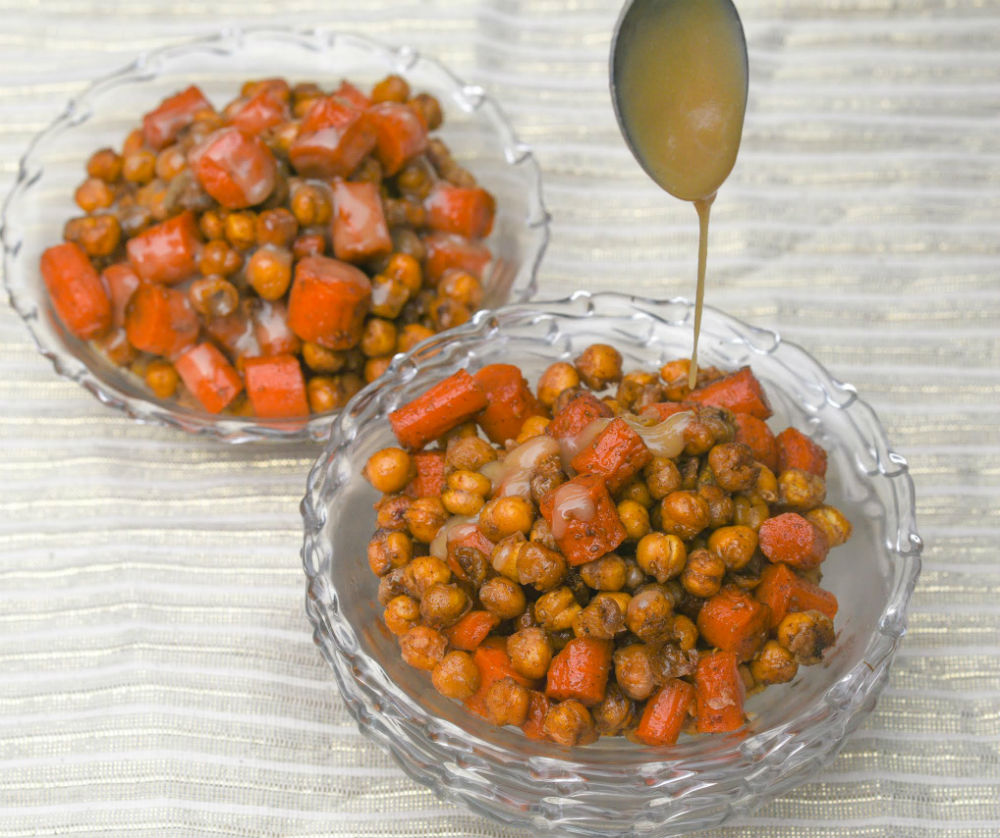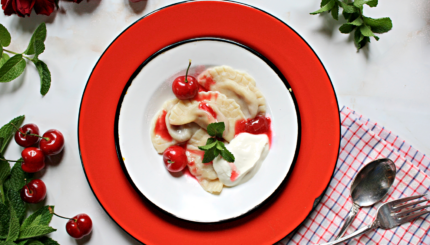Carrots are a core ingredient so ancient that recipes with carrots are found in Roman cookbooks. However, they did not take hold as a widely popular food in cooking until later, during the Middle Ages. Carrots were also popular in Sephardic countries, in old recipes like Moroccan carrot salad, which transferred to Israel and the Americas; they have become an open canvas for flavors on previously Ashkenazi-only tables.
In the American-Ashkenazi food lexicon, cinnamon is often only used in sweet dishes, and cumin in savory, but in other parts of the world, they’ve played many roles. This recipe highlights the spices’ inherent flexibility — a modern touch really, since chefs love the interplay of sweet and savory.

This recipe was designed for the High Holidays, with the Ashkenazi imagery and historical meaning of the coin-shaped sliced carrots as the wish for prosperity, the symbolism of beans or peas in a Sephardic Rosh Hashanah seder and for everyone, the circular, round shapes of both the chickpeas and carrots as a reinforcement of the circle of life.
The Nosher celebrates the traditions and recipes that have brought Jews together for centuries. Donate today to keep The Nosher's stories and recipes accessible to all.
I follow the tradition of avoiding sour food for , and serve a meal that is the physical harbinger of a sweet New Year. I have the rest of the year to focus on the sour and bittersweet, so I skip lemon zest in this dish when it’s for a New Year’s meal. When I make it as a side dish for other meals during the year, I pile on lemon zest galore and add the juice of one or two lemons to thin out the tahini.
Note: If you are not making this for Rosh Hashanah, add the juice and zest of two well-washed lemons (about 4 tablespoons zest and 6 tablespoons lemon juice) when you mix the tahini sauce. If this is being served with a dairy meal, you can also use half the amount of lemon juice and zest and add yogurt or kefir to thin the tahini sauce.
Honeyed Carrots and Roasted Chickpeas with Tahini
Ingredients
2 (15-ounce) cans chickpeas
3 Tbsp olive oil, divided
1 Tbsp kosher salt, divided
1½ tsp freshly ground white pepper, divided
1 tsp ground cinnamon, roasted preferred, divided
1 tsp ground cumin, roasted preferred, divided
Pinch of saffron (about 5 to 7 threads)
½ cup honey
⅓ cup dark brown sugar
1 lb carrots, multicolored
¼ cup tahini
3 to 5 Tbsp vegetable stock or water, as needed
Directions
Heat the oven to 400°F. Line 2 rimmed baking sheets with parchment paper and set aside.
Place the cooked chickpeas in a large strainer and rinse under cold running water until the water runs clear. Remove and discard any chickpea skins. Transfer to a large mixing bowl and add 2 tablespoons of the olive oil, 1 teaspoon salt, 1 teaspoon white pepper, ½ teaspoon cinnamon, ½ teaspoon cumin, and the saffron and mix well until fully coated. Spread the chickpeas on the prepared baking sheet in a single, even layer and bake for 10 minutes.
While the chickpeas are baking, trim and peel the carrots and cut them into ½-inch rounds. Place in a mixing bowl with the remaining 1 tablespoon of oil, 2 teaspoons salt, ½ teaspoon white pepper, ½ teaspoon cinnamon, ½ teaspoon cumin, 2 tablespoons of the honey, and the brown sugar and mix to coat well.
Spread the carrots on the second baking sheet in a single, even layer. When the chickpeas have baked for about 10 minutes, place the sheet containing the carrots on another rack in the oven (with the chickpeas still baking). Bake the carrots for 10 minutes.
Remove the pan from the oven, stir the carrots, spread them out in a single layer again, cover with foil, and bake for about 10 minutes longer, or until the carrots are crisp-tender. Stir the chickpeas while you have the oven open.
When the chickpeas have baked for about 30 minutes and the carrots, for about 20 minutes, remove the pans from the oven and, using a slotted spoon, scoop both into a serving bowl and mix gently.
In a small bowl, mix together the tahini, the remaining honey, and any accumulated cooking juices from the carrot pan and stir the mixture well. If the sauce seems too thick to drizzle, add the water, a little at a time, and stir to combine, until you reach the consistency that looks right to you.
Drizzle the tahini sauce decoratively across the top of the chickpeas and carrots, like a thick icing, in a zigzag pattern, and keep warm until ready to serve.



